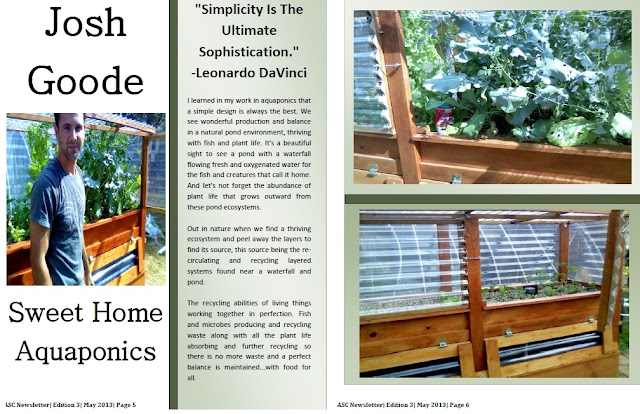Sweet Home Aquaponics Meet Josh Goode
"Simplicity Is The Ultimate Sophistication." -Leonardo DaVinci
I learned in my work in aquaponics that a simple design is always the best. We see wonderful production and balance in a natural pond environment, thriving with fish and plant life. It's a beautiful sight to see a pond with a waterfall flowing fresh and oxygenated water for the fish and creatures that call it home. And let's not forget the abundance of plant life that grows outward from these pond ecosystems.
Out in nature when we find a thriving ecosystem and peel away the layers to find its source, this source being the re-circulating and recycling layered systems found near a waterfall and pond.
The recycling abilities of living things working together in perfection. Fish and microbes producing and recycling waste along with all the plant life absorbing and further recycling so there is no more waste and a perfect balance is maintained...with food for all.
One thing I love about aquaponics is that we borrow that magic found in a pond environment and simplify it down into a platform to grow food for us. There are many designs that have been successful in aquaponics, my thought was to design an aquaponics system that is mostly automated and user-friendly.
A design that someone with light construction skills can build themselves and most materials can be found locally. Then give the platform the ability to be "off the grid" and powered by the sun, replenished by the rain, and protected from all the hordes of critters out there. This article is about one of my favorite designs in aquaponics, the Solar Aquaponic Greenhouse.
The design is basic wood frame construction with pond liners for water-proofing, materials that can mostly be found at your local home improvement store. The pond is the base of the system with about 18 inches of water and a thin gravel layer along the bottom. The system in the photos is 8 feet long by 2 feet wide, so the pond when full of water is about 120 gallons. A good fish ratio is 1 fish per 10 gallons of pond water. So I put 12 Tilapia in the pond to get it started. Then a submersible water pump placed at the bottom of the pond will pump the water to the grow-bed above, bringing nutrient rich pond water to the plants.
Bacteria break down the fish effluent and releases molecules that are then absorbed by the plants. Then the filtered water drains back into the pond, simulating a waterfall and oxygenating the pond water for the fish.
A small aquarium air pump with an air strip on the bottom of the pond provides further oxygenation for the fish. These two pumps are the only electronics needed to run the system and are powered by a solar panel/boat battery/inverter kit. These components are housed inside a small cabinet below the grow-bed to provide protection from the sun and elements. The solar panel charges a marine battery, a 500 watt power inverter is connected to the battery, and then both the water pump and air pump are plugged into the inverter, each with a simple 30 minute mechanical timer.
If you would like to read more about Josh's story and his cool aquaponics system, we have his full article in the May 2013 Edition of the ASC Magazine.
You can purchase all the back issues here:
Or
Subscribe to the magazine by purchasing a lifetime subscription here:

No comments:
Post a Comment
Note: Only a member of this blog may post a comment.